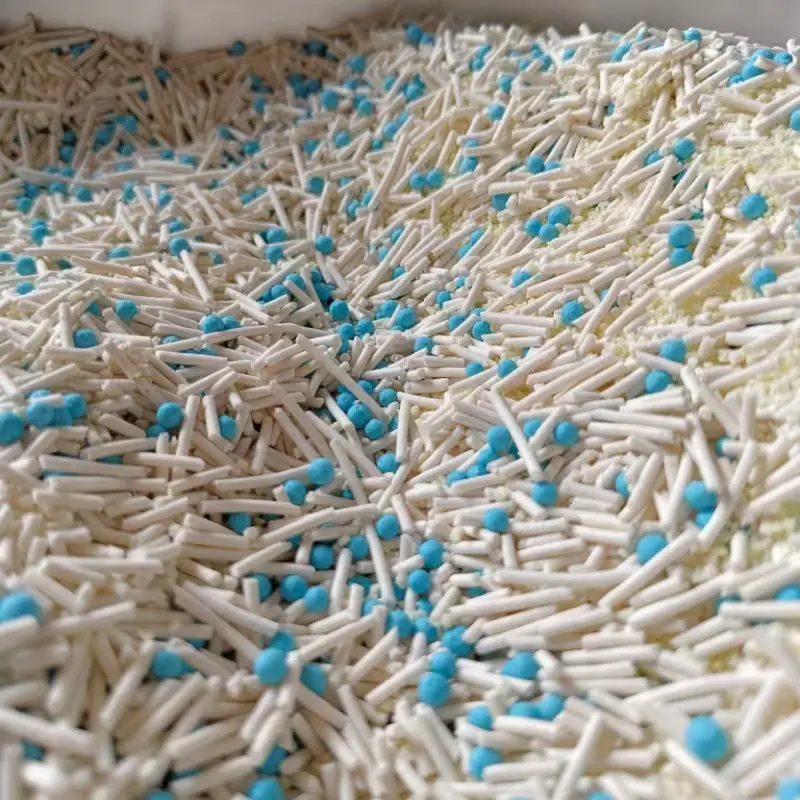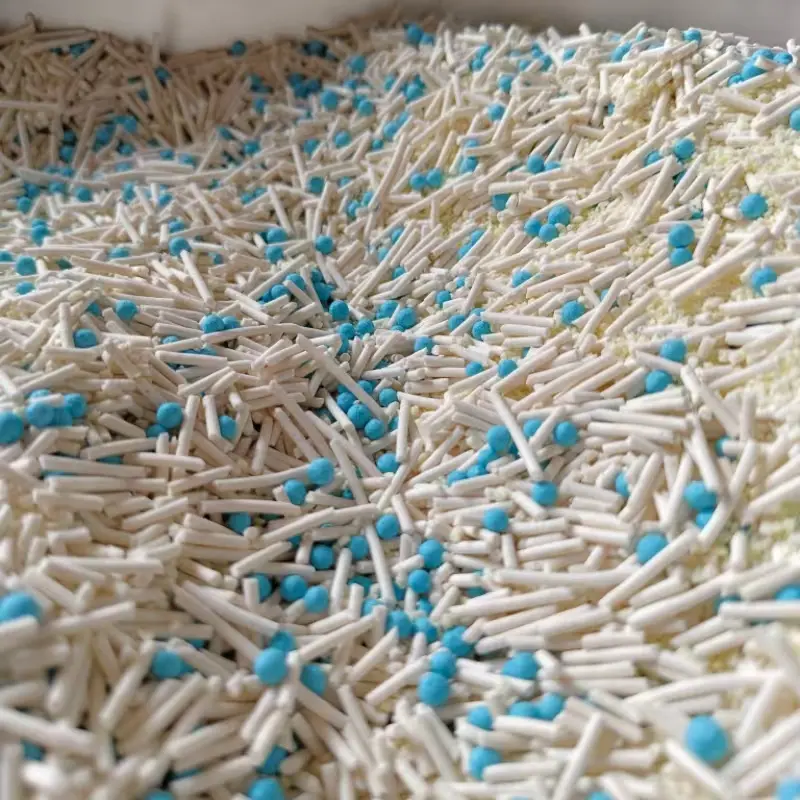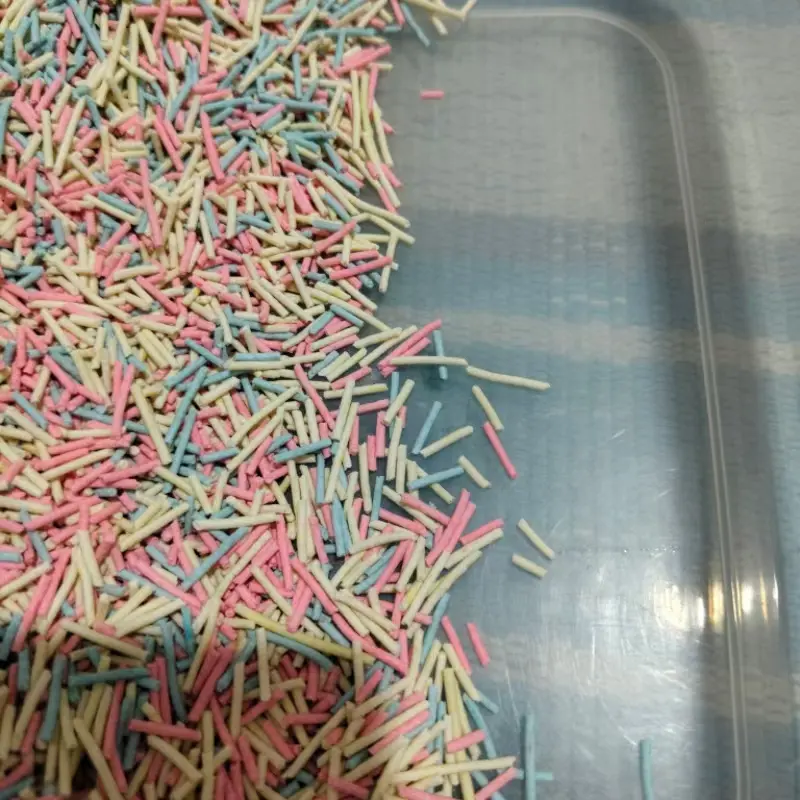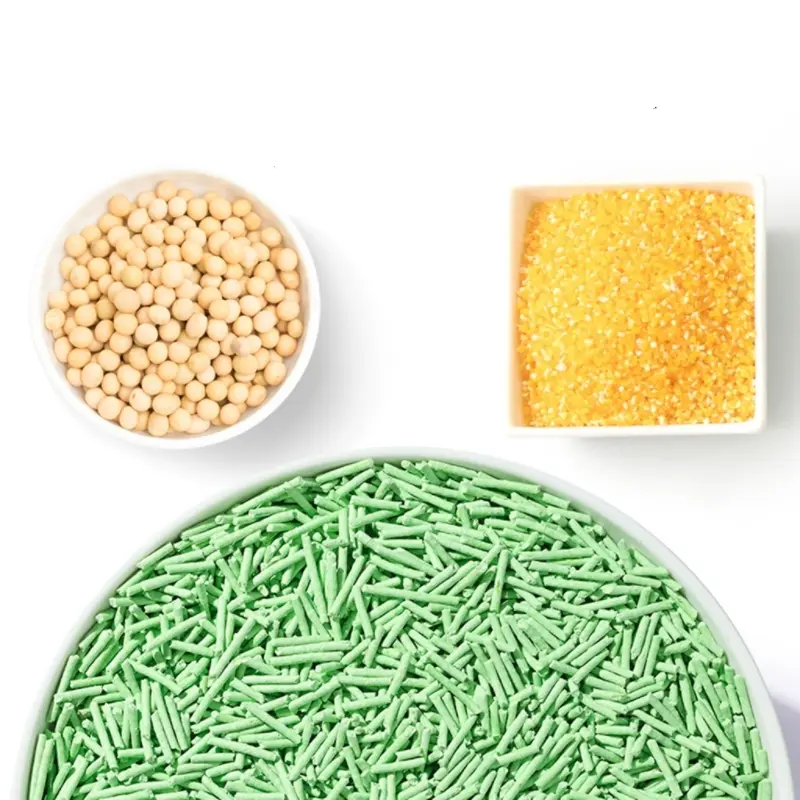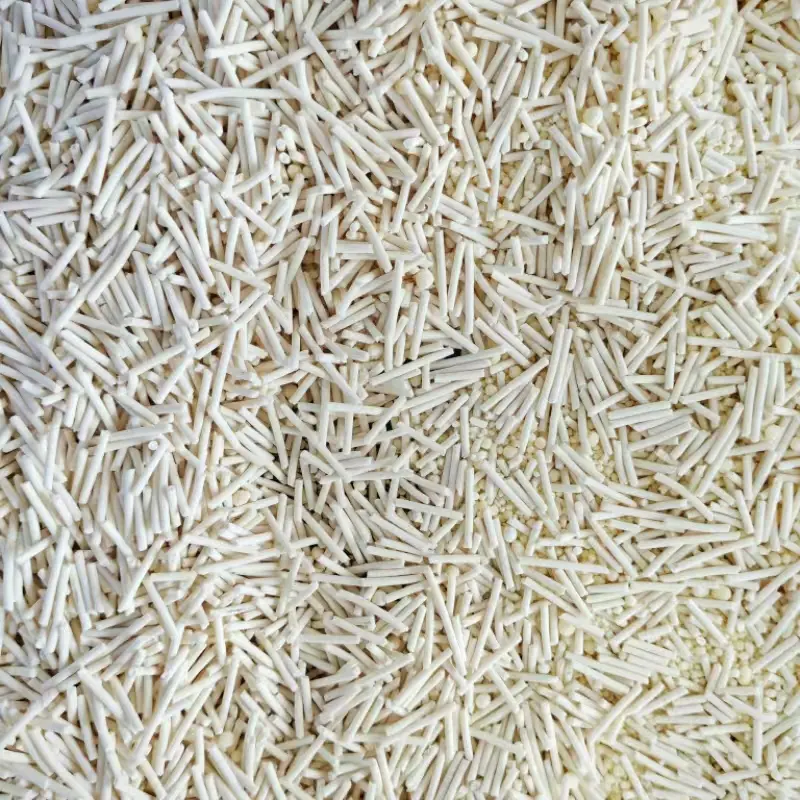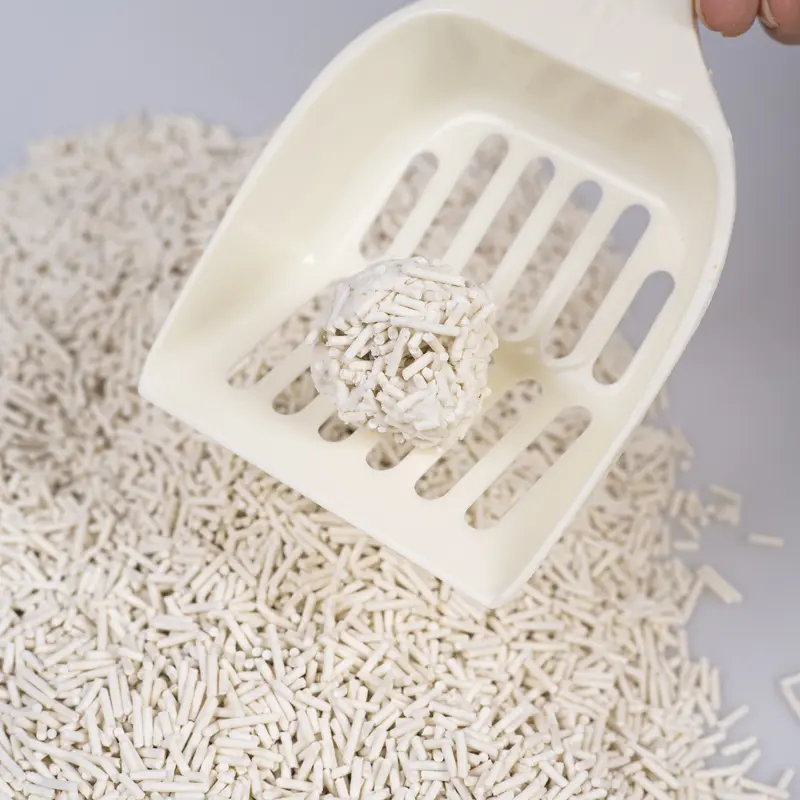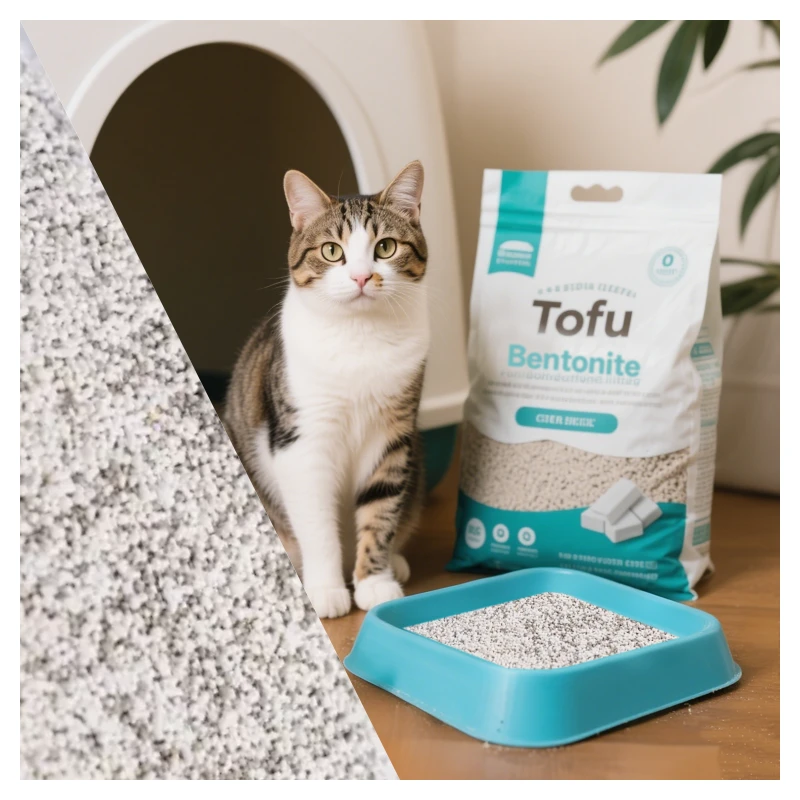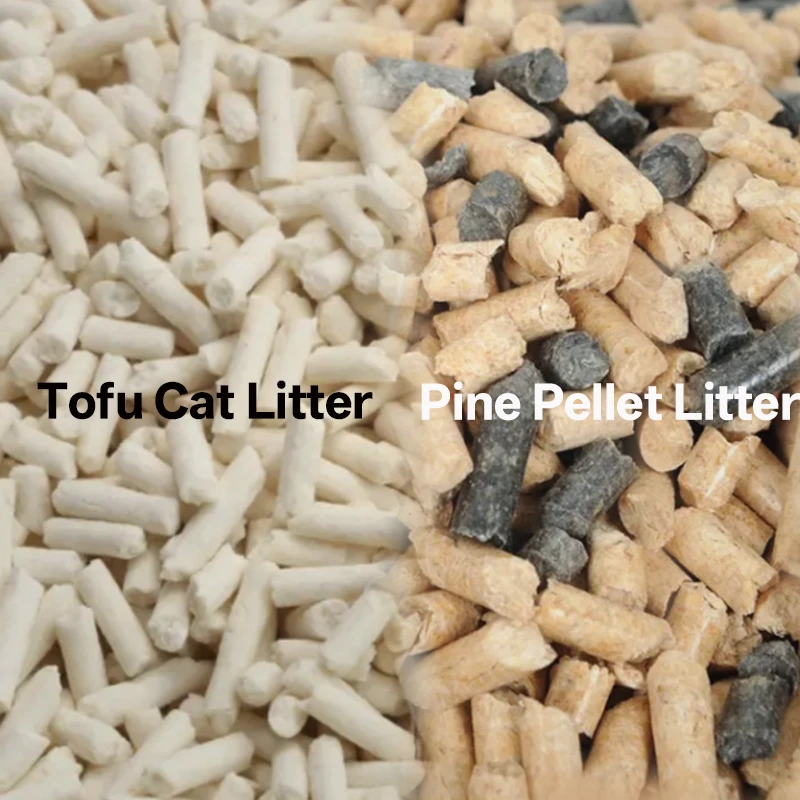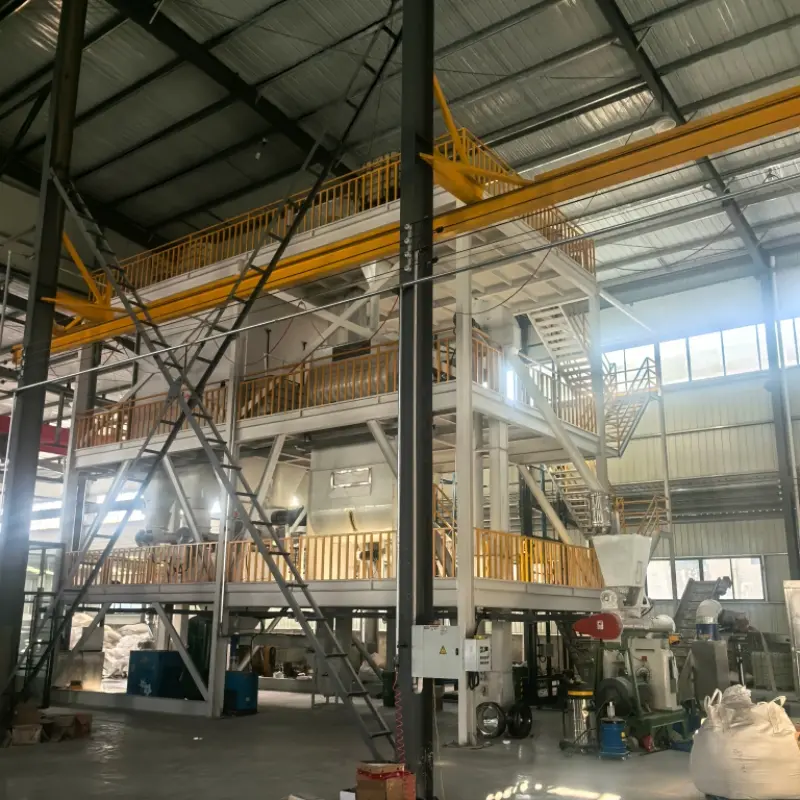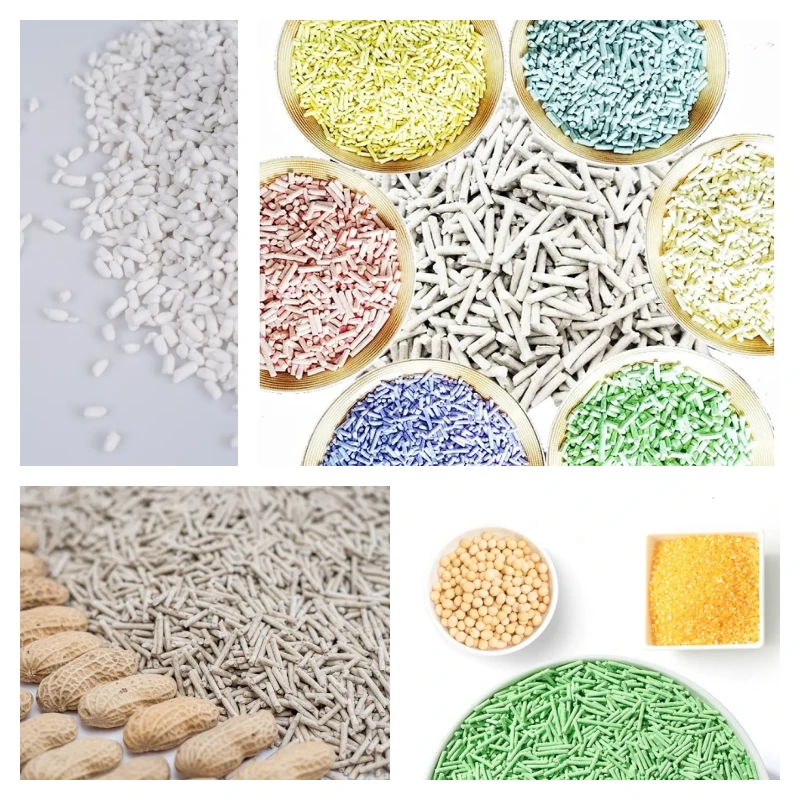Choosing the right cat litter is crucial for both feline and owner satisfaction. Here's an overview of ten common types of cat litter, highlighting their respective advantages and disadvantages.
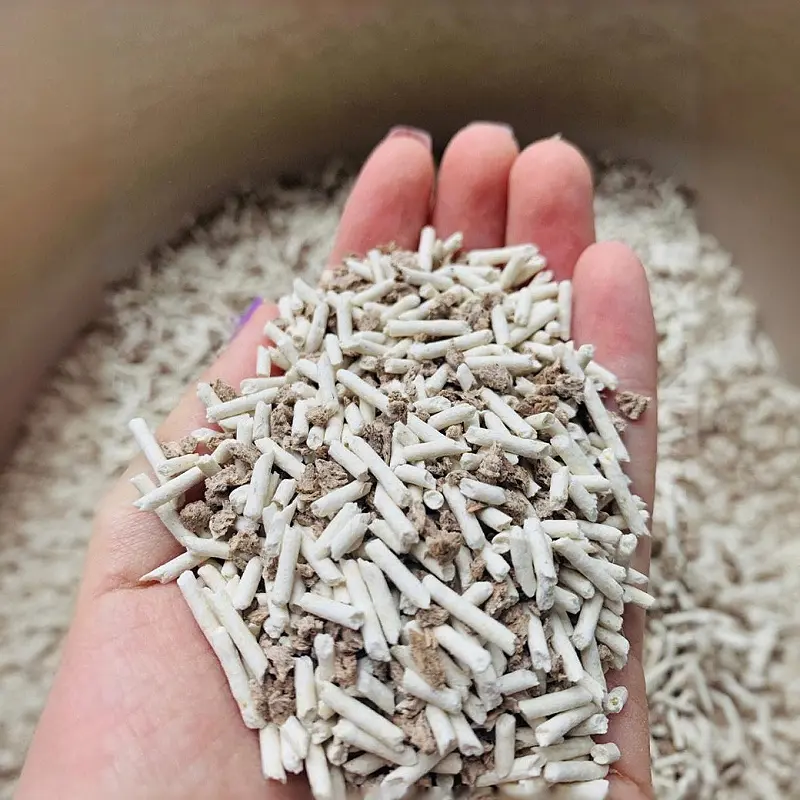
1. Clumping Clay Cat Litter pros and cons
Clumping clay cat litter is a type of cat litter made primarily from natural clay minerals, such as sodium bentonite or calcium bentonite. It's designed to form solid clumps when it comes into contact with moisture, making it easier to scoop out soiled areas and maintain cleanliness in the litter box.
Pros
Affordability: Non-clumping clay cat litter is often more budget-friendly compared to clumping varieties and other types of litter, making it an economical choice for cat owners on a tight budget.
Absorbency: Non-clumping clay litter is generally quite absorbent, effectively soaking up moisture and controlling odors in the litter box.
Longevity: Since it doesn't form clumps, non-clumping clay litter tends to last longer in the litter box before needing to be completely replaced. This can result in fewer litter changes over time.
Availability: Non-clumping clay litter is widely available at most pet stores and supermarkets, making it convenient to purchase.
Less Dust: Non-clumping clay litter typically produces less dust compared to some other types of litter, which can be beneficial for both cats and owners with respiratory sensitivities.
Cons
Tracking: Non-clumping clay litter can be prone to tracking, as the particles can stick to your cat's paws and be carried out of the litter box, potentially leading to messes around the house.
Odor Control: While non-clumping clay litter does absorb moisture and control odors to some extent, it may not be as effective at odor control as clumping or alternative litters that use specialized odor-neutralizing agents.
Messy Cleanup: Without clumping action, waste tends to mix with the rest of the litter, making it more challenging to scoop out soiled areas and resulting in more frequent complete litter changes.
Heavyweight: Non-clumping clay litter can be heavier than clumping or lightweight alternatives, making it more cumbersome to carry and pour, especially for those with mobility issues.
Potential for Urine Pooling: In multi-cat households or with cats who urinate heavily, urine may pool at the bottom of the litter box, leading to an unpleasant odor and requiring more frequent box cleanings.
Non-clumping clay cat litter offers affordability and decent odor control, but it may be less convenient to clean and prone to tracking compared to clumping varieties. Understanding these pros and cons can help cat owners make informed decisions when choosing the most suitable litter for their feline companions.
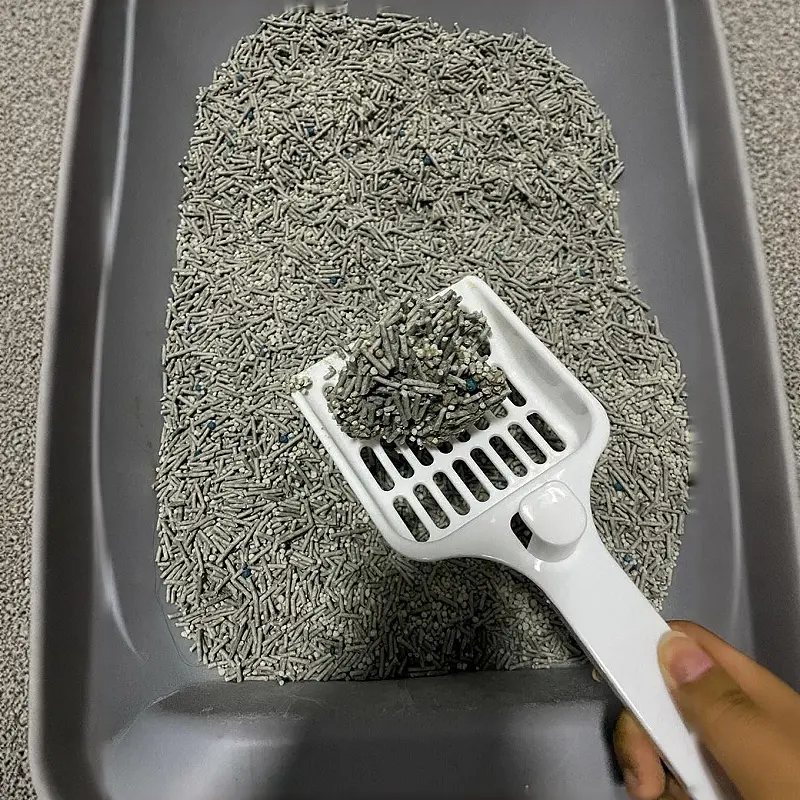
2. Non-Clumping Clay Cat Litter pros and cons
Non-clumping clay cat litter is a type of cat litter made primarily from natural clay minerals, such as sodium bentonite or calcium bentonite. Unlike clumping clay litter, which forms solid clumps when it comes into contact with moisture, non-clumping clay litter does not clump together.This type of litter is typically mined from natural clay deposits, processed, and then granulated into small particles. It's often marketed as a cost-effective option for cat owners who prefer simplicity in litter box maintenance.
Pros
Affordability: Non-clumping clay cat litter is often more budget-friendly compared to clumping varieties and other types of litter, making it an economical choice for cat owners.
Absorbency: Non-clumping clay litter is typically quite absorbent, effectively soaking up moisture and controlling odors in the litter box.
Availability: Non-clumping clay litter is widely available at most pet stores and supermarkets, making it convenient to purchase.
Low Dust: Many non-clumping clay litters are formulated to produce minimal dust, which can be beneficial for both cats and owners with respiratory sensitivities.
Longevity: Since it doesn't form clumps, non-clumping clay litter tends to last longer in the litter box before needing to be completely replaced. This can result in fewer litter changes over time.
Cons
Messy Cleanup: Without clumping action, waste tends to mix with the rest of the litter, making it more challenging to scoop out soiled areas and resulting in more frequent complete litter changes.
Odor Control: While non-clumping clay litter does absorb moisture and control odors to some extent, it may not be as effective at odor control as clumping or alternative litters that use specialized odor-neutralizing agents.
Tracking: Non-clumping clay litter can be prone to tracking, as the particles can stick to your cat's paws and be carried out of the litter box, potentially leading to messes around the house.
Weight: Non-clumping clay litter can be heavier than clumping or lightweight alternatives, making it more cumbersome to carry and pour, especially for those with mobility issues.
Potential for Urine Pooling: In multi-cat households or with cats who urinate heavily, urine may pool at the bottom of the litter box, leading to an unpleasant odor and requiring more frequent box cleanings.
Non-clumping clay cat litter offers affordability and decent odor control, but it may be less convenient to clean and prone to tracking compared to clumping varieties. Understanding these pros and cons can help cat owners make informed decisions when choosing the most suitable litter for their feline companions.
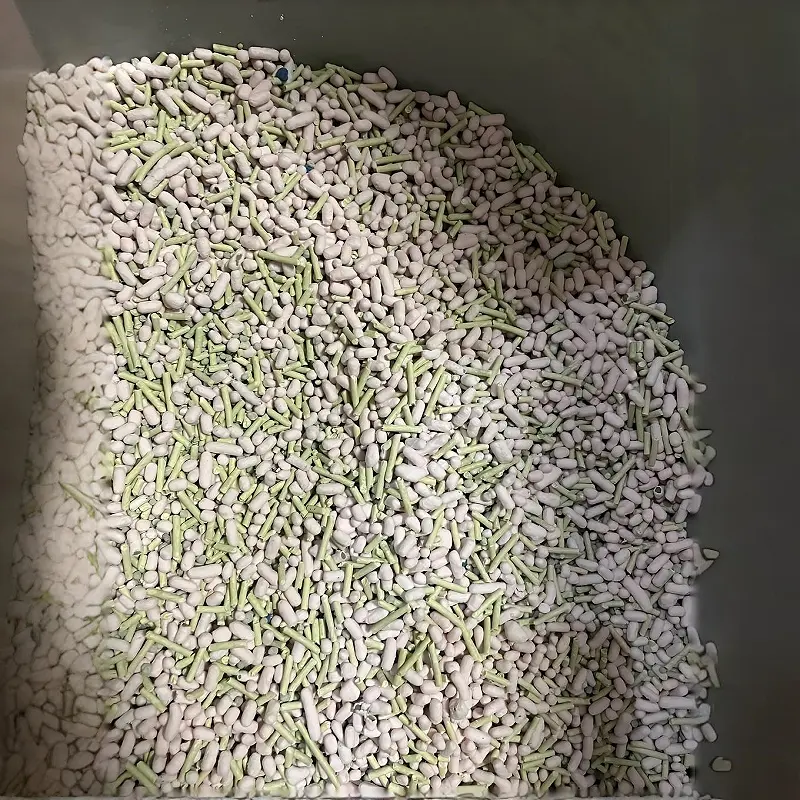
3. Silica Gel Cat Litter pros and cons
Silica gel cat litter is a type of cat litter made from silica gel crystals. These crystals are highly absorbent and are capable of trapping moisture effectively.
Pros
Superior Absorbency: Silica gel cat litter is highly absorbent, capable of trapping moisture quickly and effectively. This helps to keep the litter box dry and minimize odors.
Excellent Odor Control: Due to its absorbent properties, silica gel litter is very effective at controlling odors. It locks in moisture and prevents the growth of odor-causing bacteria, keeping the litter box fresher for longer periods.
Low Dust: Silica gel litter produces minimal dust, making it a suitable option for cats and owners with respiratory sensitivities. It creates a cleaner environment and reduces the risk of respiratory issues.
Long-Lasting: Silica gel litter tends to last longer than traditional clumping or non-clumping clay litters. It can remain effective for several weeks before needing to be completely replaced, reducing the frequency of litter changes.
Easy Cleanup: Silica gel litter does not clump like clay litter, which makes scooping waste a simpler task. The solid waste can be easily removed from the litter box without disturbing the remaining litter.
Cons
Cost: Silica gel cat litter is typically more expensive than traditional clay litters. While it offers superior performance, the higher cost may be a deterrent for some cat owners, especially those on a tight budget.
Non-Biodegradable: Silica gel litter is not biodegradable, which means it cannot be composted like some other types of litter. Proper disposal methods should be followed to minimize environmental impact.
Non-Flushable: Due to its non-biodegradable nature and potential to expand when exposed to moisture, silica gel litter should not be flushed down the toilet. Disposal in the trash is recommended.
Not Suitable for Cats with Ingestion Risk: Some cats may be tempted to ingest silica gel litter due to its texture and appearance. This can pose a risk of intestinal blockages or other health issues, especially if large quantities are consumed.
Potential for Tracking: While silica gel litter produces less dust than clay litter, the small crystals can still be tracked out of the litter box on cats' paws. Placing a mat outside the litter box can help minimize tracking.
Silica gel cat litter offers superior absorbency and odor control compared to traditional litters, but it comes with a higher price tag and is not biodegradable. Understanding these pros and cons can help cat owners determine if silica gel litter is the right choice for their feline companions.
4. Plant-Based Cat Litter (e.g., Corn, Wheat, Pine, Paper) pros and cons
Plant-based cat litter refers to cat litter made from various renewable and biodegradable plant materials, providing an eco-friendly alternative to traditional clay or silica gel litters.
Each type of plant-based cat litter has its own unique characteristics and benefits. Cat owners can choose the type of litter that best suits their cat's preferences and their own preferences in terms of odor control, clumping ability, dust level, and environmental impact.
Here are the pros and cons of using plant-based cat litter, such as those made from corn, wheat, pine, or paper:
Pros
Biodegradable: Plant-based cat litters are typically biodegradable, making them environmentally friendly options. They can break down naturally over time, reducing waste and minimizing environmental impact.
Low Dust: Many plant-based litters produce minimal dust, which can benefit both cats and owners with respiratory sensitivities. It creates a cleaner litter box environment and reduces the risk of respiratory issues.
Natural Odor Control: Some plant-based litters, such as those made from pine or cedar, have natural odor-neutralizing properties. They can help absorb and mask unpleasant odors, keeping the litter box smelling fresh.
Clumping Options Available: Some plant-based litters offer clumping formulas, which can simplify litter box maintenance by allowing for easy removal of soiled clumps.
Variety of Options: Plant-based litters come in a variety of materials, including corn, wheat, pine, and paper. This variety allows cat owners to choose the type of litter that best suits their cat's preferences and their own preferences in terms of odor control, texture, and eco-friendliness.
Cons
Tracking: Plant-based litters, especially those with larger granules or particles, can be prone to tracking outside the litter box on cats' paws. Placing a mat outside the litter box can help minimize tracking.
Potential for Messiness: Some plant-based litters may be less effective at clumping or controlling odors compared to traditional clay or silica gel litters. This can result in a messier litter box environment and more frequent litter changes.
Attractiveness to Pests: Certain plant-based litters, such as those made from corn or wheat, may attract pests like ants or rodents if not stored properly. Ensuring proper storage in airtight containers can help mitigate this risk.
Transition Period: Cats may require a transition period to adjust to new plant-based litters, especially if they are used to a different type of litter. Some cats may be resistant to change and may need time to become accustomed to the new litter.
Absorbency: While many plant-based litters offer good absorbency, they may not be as effective at controlling odors as some other types of litter. Regular litter box maintenance, including frequent scooping and litter changes, may be necessary to keep odors at bay.
Plant-based cat litters offer biodegradability, low dust, and natural odor control, but they may be prone to tracking and require regular maintenance to control odors effectively. Understanding these pros and cons can help cat owners make informed decisions when choosing the most suitable litter for their feline companions.

5. Recycled Paper Cat Litter pros and cons
Recycled paper cat litter is a type of cat litter made from recycled paper products, such as newspapers, cardboard, or other paper materials.
Here are the pros and cons of using recycled paper cat litter:
Pros
Biodegradable: Recycled paper cat litter is made from recycled paper products, making it an environmentally friendly option. It breaks down naturally over time, reducing waste and minimizing environmental impact.
Low Dust: Recycled paper litter produces minimal dust, which can benefit both cats and owners with respiratory sensitivities. It creates a cleaner litter box environment and reduces the risk of respiratory issues.
High Absorbency: Recycled paper litter is typically highly absorbent, effectively soaking up moisture and controlling odors in the litter box. It can help keep the litter box dry and minimize odor buildup.
Gentle on Paws: The soft texture of recycled paper litter is gentle on cats' sensitive paw pads, making it a comfortable option for cats to use.
Lightweight: Recycled paper litter is often lighter in weight compared to traditional clay litters, making it easier to carry and pour. This can be particularly beneficial for cat owners with mobility issues.
Cons
Tracking: Recycled paper litter, especially those with larger granules or particles, can be prone to tracking outside the litter box on cats' paws. Placing a mat outside the litter box can help minimize tracking.
Potential for Messiness: While recycled paper litter is absorbent, it may not clump as effectively as some other types of litter. This can result in a messier litter box environment and more frequent litter changes.
Odor Control: While recycled paper litter can absorb moisture and control odors to some extent, it may not be as effective at odor control as clumping litters or litters with added odor-neutralizing agents. Regular litter box maintenance, including frequent scooping and litter changes, may be necessary to keep odors at bay.
Not Suitable for Outdoor Use: Recycled paper litter can break down when exposed to moisture, making it unsuitable for outdoor use in covered or semi-covered litter boxes.
Transition Period: Cats may require a transition period to adjust to new recycled paper litter, especially if they are used to a different type of litter. Some cats may be resistant to change and may need time to become accustomed to the new litter.
Recycled paper cat litter offers biodegradability, low dust, and high absorbency, but it may be prone to tracking and require regular maintenance to control odors effectively. Understanding these pros and cons can help cat owners make informed decisions when choosing the most suitable litter for their feline companions.
6. Tofu Cat Litter pros and cons
Tofu cat litter, also known as tofu-based cat litter or tofu clumping cat litter, is a type of cat litter made from tofu residue or soybean dregs, a by-product of tofu production.
Pros
Biodegradable: Tofu cat litter is made from tofu by-products, such as soybean dregs, making it an environmentally friendly option. It breaks down naturally over time, reducing waste and minimizing environmental impact.
Natural Odor Control: Tofu cat litter has natural odor-absorbing properties, helping to neutralize unpleasant odors in the litter box. It can keep the litter box smelling fresh without the use of added chemicals or fragrances.
Low Dust: Tofu cat litter produces minimal dust, which can benefit both cats and owners with respiratory sensitivities. It creates a cleaner litter box environment and reduces the risk of respiratory issues.
Clumping Action: Some tofu cat litters offer clumping formulas, which can simplify litter box maintenance by allowing for easy removal of soiled clumps. This makes scooping waste easier and helps keep the litter box clean.
Gentle on Paws: The soft texture of tofu cat litter is gentle on cats' sensitive paw pads, making it a comfortable option for cats to use.
Cons
Availability: Tofu cat litter may not be as readily available as traditional clay or silica gel litters, depending on location. Finding a reliable source may require some research or ordering online.
Cost: Tofu cat litter can be more expensive than traditional litters, which may be a deterrent for some cat owners, especially those on a tight budget.
Potential for Tracking: Tofu cat litter, especially those with larger granules or particles, can be prone to tracking outside the litter box on cats' paws. Placing a mat outside the litter box can help minimize tracking.
Absorbency: While tofu cat litter is absorbent, it may not be as effective at controlling odors as some other types of litter. Regular litter box maintenance, including frequent scooping and litter changes, may be necessary to keep odors at bay.
Transition Period: Cats may require a transition period to adjust to new tofu cat litter, especially if they are used to a different type of litter. Some cats may be resistant to change and may need time to become accustomed to the new litter.
Tofu cat litter offers biodegradability, natural odor control, and low dust, but it may be more expensive and require regular maintenance to control odors effectively. Understanding these pros and cons can help cat owners make informed decisions when choosing the most suitable litter for their feline companions.
7. Wood Pellet Cat Litter pros and cons
Wood pellet cat litter is a type of cat litter made from compressed wood particles or sawdust.
Pros
Biodegradable: Wood pellet cat litter is made from compressed wood particles, making it biodegradable and environmentally friendly. It breaks down naturally over time, reducing waste and minimizing environmental impact.
Natural Odor Control: Wood pellets have natural odor-neutralizing properties, helping to absorb and mask unpleasant odors in the litter box. They can keep the litter box smelling fresh without the use of added chemicals or fragrances.
High Absorbency: Wood pellet cat litter is highly absorbent, effectively soaking up moisture and controlling odors in the litter box. It can help keep the litter box dry and minimize odor buildup.
Clumping Action: Some wood pellet cat litters offer clumping formulas, which can simplify litter box maintenance by allowing for easy removal of soiled clumps. This makes scooping waste easier and helps keep the litter box clean.
Gentle on Paws: The smooth texture of wood pellets is gentle on cats' sensitive paw pads, making it a comfortable option for cats to use.
Cons
Tracking: Wood pellet cat litter, especially when it breaks down into sawdust, can be prone to tracking outside the litter box on cats' paws. Placing a mat outside the litter box can help minimize tracking.
Potential for Messiness: While wood pellet litter is absorbent, it may not clump as effectively as some other types of litter. This can result in a messier litter box environment and more frequent litter changes.
Cost: Wood pellet cat litter can be more expensive than traditional litters, which may be a deterrent for some cat owners, especially those on a tight budget.
Storage Space: Wood pellet cat litter may require more storage space compared to other types of litter due to its bulkiness, especially if purchased in large quantities.
Transition Period: Cats may require a transition period to adjust to new wood pellet cat litter, especially if they are used to a different type of litter. Some cats may be resistant to change and may need time to become accustomed to the new litter.
Wood pellet cat litter offers biodegradability, natural odor control, and high absorbency, but it may be prone to tracking and require regular maintenance to control odors effectively. Understanding these pros and cons can help cat owners make informed decisions when choosing the most suitable litter for their feline companions.
8. Crystal Cat Litter pros and cons
Crystal cat litter, also known as silica gel cat litter or silica crystal cat litter, is a type of cat litter made from silica gel crystals.
Pros
Superior Absorbency: Crystal cat litter is highly absorbent, capable of trapping moisture quickly and effectively. This helps to keep the litter box dry and minimize odors.
Excellent Odor Control: Due to its absorbent properties, crystal litter is very effective at controlling odors. It locks in moisture and prevents the growth of odor-causing bacteria, keeping the litter box fresher for longer periods.
Low Dust: Crystal cat litter produces minimal dust, making it a suitable option for cats and owners with respiratory sensitivities. It creates a cleaner environment and reduces the risk of respiratory issues.
Long-Lasting: Crystal cat litter tends to last longer than traditional clumping or non-clumping clay litters. It can remain effective for several weeks before needing to be completely replaced, reducing the frequency of litter changes.
Easy Cleanup: Crystal cat litter does not clump like clay litter, which makes scooping waste a simpler task. The solid waste can be easily removed from the litter box without disturbing the remaining litter.
Cons
Cost: Crystal cat litter is typically more expensive than traditional litters, which may be a deterrent for some cat owners, especially those on a tight budget.
Non-Biodegradable: Crystal litter is not biodegradable, which means it cannot break down naturally over time. Proper disposal methods should be followed to minimize environmental impact.
Non-Flushable: Due to its non-biodegradable nature and potential to expand when exposed to moisture, crystal litter should not be flushed down the toilet. Disposal in the trash is recommended.
Potential for Ingestion: Some cats may be tempted to ingest crystal litter due to its texture and appearance. This can pose a risk of intestinal blockages or other health issues, especially if large quantities are consumed.
Transition Period: Cats may require a transition period to adjust to new crystal litter, especially if they are used to a different type of litter. Some cats may be resistant to change and may need time to become accustomed to the new litter.
Crystal cat litter offers superior absorbency, odor control, and low dust, but it comes with a higher price tag and is not biodegradable. Understanding these pros and cons can help cat owners determine if crystal litter is the right choice for their feline companions.
9. Bamboo Cat Litter pros and cons
Bamboo cat litter is a type of cat litter made from bamboo fibers. Bamboo cat litter is made from natural, renewable bamboo fibers, making it an eco-friendly choice for cat owners concerned about sustainability. Bamboo is a fast-growing plant that can be harvested without causing damage to the environment.
Certainly! Here are the pros and cons of using bamboo cat litter:
Pros
Biodegradable: Bamboo cat litter is made from bamboo fibers, a renewable and sustainable resource. It breaks down naturally over time, reducing waste and minimizing environmental impact.
Natural Odor Control: Bamboo cat litter has natural antibacterial properties that help to neutralize odors in the litter box. It can keep the litter box smelling fresh without the use of added chemicals or fragrances.
Low Dust: Bamboo cat litter produces minimal dust, which can benefit both cats and owners with respiratory sensitivities. It creates a cleaner litter box environment and reduces the risk of respiratory issues.
High Absorbency: Bamboo cat litter is highly absorbent, effectively soaking up moisture and controlling odors in the litter box. It can help keep the litter box dry and minimize odor buildup.
Clumping Options Available: Some bamboo cat litters offer clumping formulas, which can simplify litter box maintenance by allowing for easy removal of soiled clumps. This makes scooping waste easier and helps keep the litter box clean.
Cons
Cost: Bamboo cat litter can be more expensive than traditional litters, which may be a deterrent for some cat owners, especially those on a tight budget.
Potential for Tracking: Bamboo cat litter, especially those with larger granules or particles, can be prone to tracking outside the litter box on cats' paws. Placing a mat outside the litter box can help minimize tracking.
Absorbency: While bamboo cat litter is absorbent, it may not be as effective at controlling odors as some other types of litter. Regular litter box maintenance, including frequent scooping and litter changes, may be necessary to keep odors at bay.
Transition Period: Cats may require a transition period to adjust to new bamboo cat litter, especially if they are used to a different type of litter. Some cats may be resistant to change and may need time to become accustomed to the new litter.
Availability: Bamboo cat litter may not be as readily available as traditional clay or silica gel litters, depending on location. Finding a reliable source may require some research or ordering online.
Bamboo cat litter offers biodegradability, natural odor control, and low dust, but it may be more expensive and require regular maintenance to control odors effectively. Understanding these pros and cons can help cat owners make informed decisions when choosing the most suitable litter for their feline companions.
10. Walnut Shell Cat Litter pros and cons
Walnut shell cat litter is a type of cat litter made from crushed walnut shells. Here are some key characteristics, along with the pros and cons:
Pros
Natural Ingredients: Walnut shell cat litter is made from natural, biodegradable materials, making it an environmentally friendly option for cat owners concerned about sustainability.
Absorbency: Walnut shell cat litter is highly absorbent and capable of trapping moisture effectively. The absorbent properties of walnut shells help to control odors and keep the litter box fresh for longer periods.
Odor Control: Walnut shell cat litter offers natural odor control, thanks to its absorbent properties. The litter absorbs moisture and traps odors, preventing them from escaping into the surrounding environment.
Low Dust: Walnut shell cat litter typically produces minimal dust compared to some other types of litter, making it suitable for cats and owners with respiratory sensitivities. Low-dust formulas create a cleaner litter box environment and reduce the risk of respiratory issues.
Clumping and Non-Clumping Varieties: Walnut shell cat litter is available in both clumping and non-clumping varieties. Clumping walnut litter forms solid clumps when exposed to moisture, making it easy to scoop out soiled areas. Non-clumping walnut litter may require more frequent complete litter changes but is still effective at controlling odors.
Gentle on Paws: The soft texture of walnut shell cat litter is gentle on cats' sensitive paw pads, making it a comfortable option for cats to use.
Cons
Tracking: Some walnut shell cat litters may be prone to tracking outside the litter box on cats' paws. Placing a mat outside the litter box can help minimize tracking.
Availability: Walnut shell cat litter may not be as readily available as other types of litter, depending on location. Finding a reliable source may require some research or ordering online.
Cost: Walnut shell cat litter may be more expensive than traditional clay litters, which may be a deterrent for some cat owners, especially those on a tight budget.
Storage Space: Walnut shell cat litter may require more storage space compared to other types of litter due to its bulkiness, especially if purchased in large quantities.
Walnut shell cat litter offers natural ingredients, effective absorbency, and odor control, but it may be prone to tracking and require more storage space. Understanding these pros and cons can help cat owners make informed decisions when choosing the most suitable litter for their feline companions.
Each type of cat litter has its own set of benefits and drawbacks, so it's essential for cat owners to consider factors such as their cat's preferences, any allergies or sensitivities, odor control needs, and environmental concerns when choosing the right litter for their furry companions.

